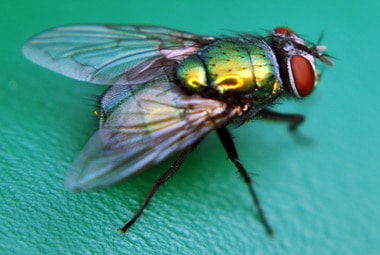
The blowfly or bottle fly, as it is commonly known, is a fly species that is associated with dead animals and people. In fact, forensic entomologists use the developmental stage of the blowfly to pinpoint the time of death. Eighty species of the blowfly are found throughout both the United States and Canada.
| Pest Identification | |
|---|---|
| Recognition | An adult blowfly is metallic green, blue, bronze, or black in color. They grow to be between 1/8 – 5/8th of an inch in length. Blowflies are slightly larger than a common housefly. They have sponge-like mouthparts. The worm-like larvae, also known as maggots, are pale yellow to white in color. They are eyeless and legless. Their back end is larger and rounder than their tapered head. Larvae have hook-like mouthparts. |
| Biology | The life cycle of the blowfly is fairly simple and quick. An adult female blowfly lays her eggs (up to 2,300) on the flesh of a dead animal. Depending on the species, the larvae will hatch in only a few hours or a few days. The maggots will bury themselves deep in the animal’s tissue to feed and go through their three developmental stages. After several days the maggots will leave their food source and enter into nearby soil to pupate. Within a few days, the blowfly will emerge from the soil as an adult, completing the life cycle. Because these flies land on feces and dead animals they can carry dangerous diseases and bacterium their bodies. If they land on human food or food prep areas they can spread and infect people with some very serious diseases. Blowflies can spread bacterium that can cause severe diarrhea and cholera, along with other pathogens that include plague, anthrax, tularemia, and tuberculosis. |
| Habits | Blowflies are found quickly gathering around animal carcasses or other sources of meat. They are generally the first organism to infect a dead body or piece of decaying meat. If blowflies are being found within your home it may be because an animal has gotten into your home and died behind the walls or in a crawl space. These pests can also be found infesting areas where there are piles of garbage, piles of decaying vegetation, and animal feces. |
| Prevention | Making some environmental changes and having a professional pest control plan in place can generally accomplish the prevention and control of blowflies around your home. To control blowflies around your home you should make sure that outdoor garbage cans are properly secured with a tight fitting lid. If you have pets, than their excrement should be routinely picked up so that it does not build up in your yard. To prevent blow flies from getting into your home be sure that all screens in doors and windows are intact and that any gaps or cracks in your home’s exterior are properly sealed. |
| Professional | If you are having problems with blowflies in your home or around your property Rottler can help. A Rottler technician will come to your property to correctly identify that it is indeed blowflies causing the infestation; if so, we will inspect your home and property to locate all the breeding and developmental areas. If control is necessary within your home we treat the infestation with an appropriately labeled insecticide. It may also be helpful to place insect light traps or sticky-surfaced traps in areas to reduce their numbers. Outside your home our technicians use residual liquid insecticides on walls located near dumpsters or other infested areas. We may also place insecticide baits at the bottoms of trashcans or dumpsters to help control their numbers. |

